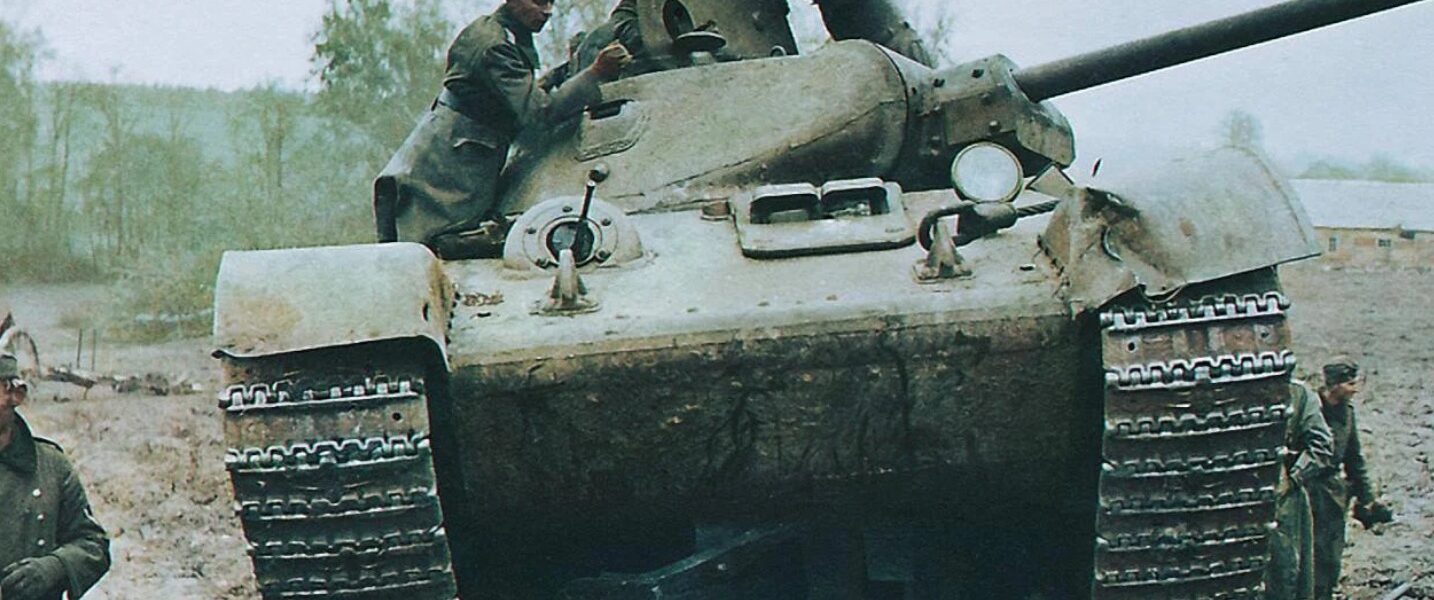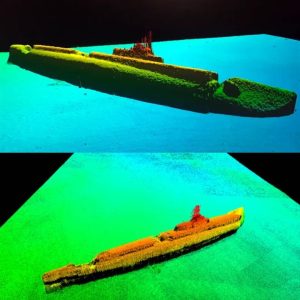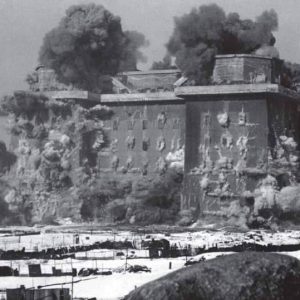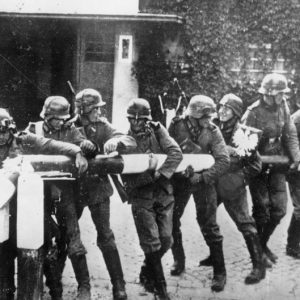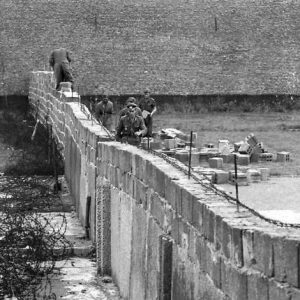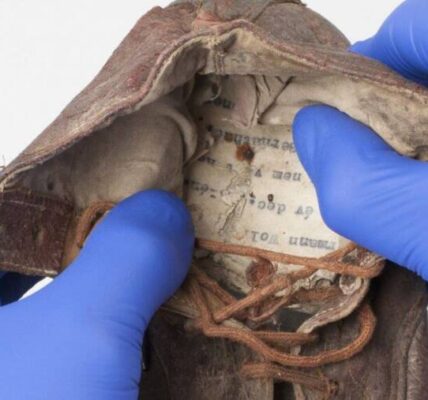

By Phil Zimmer
December 1941 was a bleak month and the end of a bleak year for the Soviets. The Germans continued to push toward Moscow, the place where Joseph Stalin and his henchmen plotted how to counter the Nazi power that had overrun everything within months. Poland had been taken, then Denmark and Norway, then Belgium and France had fallen to the Germans, whose vanguard was now reportedly within sight of the Kremlin. The German commanders were confident. They had never known defeat at that point, and an intelligence report dated December 4 made it clear that the Soviets were simply incapable of “launching a counteroffensive without significant reserves.” Unfortunately for the Germans, they were up against the Soviet T-34 tank and underestimated their opponent. (Read more about the armored vehicles and technological marvels that decisively influenced World War II in the magazine “WWII History” ).
The Wehrmacht’s doom came the very next day: The Soviets launched a massive surprise attack that, as historian Max Hastings aptly describes it, “almost literally froze the Germans in their positions.” Winter played a role: At -30 degrees Celsius, German lubricants froze, while Russian equipment, especially the T-34 tanks with their specially developed compressed air starters, functioned perfectly.
Infantryman Albrecht Linsen initially couldn’t believe his eyes at the rapid onslaught of Soviet tanks and soldiers. “German soldiers ran back from the blizzard and scattered in all directions like a panicked herd of animals. A lone officer faced this desperate mass; he gestured, tried to draw his pistol, but then simply let them pass.”
Landser Linsen was also briefly confused. There was an explosion nearby, and he “felt a stabbing pain in my right thigh. I thought, ‘I’m going to die here, 21 years old, in the snow outside Moscow.'”
The relentless Russians—reinforced by additional tanks and equipment and supported by newly arrived Siberian troops—stormed into the German salient points north and south of Moscow and continued to push forward.
For days, the Germans staggered back from the determined and relentless Soviet attacks. The invaders were pushed back 96 to 240 kilometers before General Walther Model managed to rally his troops and halt the retreat before the T-34s.

What made the T-34 tank so impressive
The Germans had encountered the robust T-34s a few months earlier during their invasion of the Soviet Union. They had learned that their medium Panzer III and IV tanks, which had successfully spearheaded the French and Polish campaigns, were simply no match for the powerful new tanks with forward-facing turrets and sloped armor that were being sent against them.
“Every shot seems to be a direct hit,” said a German anti-tank gunner at the beginning of the invasion in June 1941. “But the shells ricochet. The fire doesn’t seem to bother the tanks in the slightest,” added the astonished gunner, describing the ability of the T-34 and the heavier, less maneuverable Russian KV to counter German firepower.
The T-34 was equipped with features that German tankers would envy: thicker, sloped armor that provided even better protection against enemy fire, a robust V-12 diesel engine, a low profile, and wide tracks that made progress on snow and mud comparatively easy.
The wide tracks proved particularly important when crossing the vast areas of the motherland with its few, comparatively primitive roads, which were often little more than “mud canals” during the Rasputitsa or the weeks-long rainy periods in autumn and spring.
The Germans were initially surprised by the performance and effectiveness of the T-34 in 1941 and quickly realized that they needed to upgrade to meet the challenge posed by the Soviet tank. In November 1941, a special German Tank Investigation Committee visited the 2nd Panzer Army under Colonel General Heinz Guderian and examined several captured T-34s.
The outspoken Guderian demanded a complete rethink of German tanks, demanding significantly improved mobility, better armor protection, and a heavier main gun. This led to two distinct and competing Nazi design approaches. One, spearheaded by Daimler-Benz (designer of the Panzer III), envisioned a tank similar in appearance to the T-34, powered by a 650-hp diesel engine and rear-wheel drive.
Would Panthers be a match for the T-34?
A second design by the MAN Group, which also designed the Panzer I and II, envisioned a vehicle based on the new Maybach HL 210 gasoline engine, which had just entered production. It featured a centered turret and front-wheel drive—both features not found on the T-34.
The MAN design prevailed and became the Panther. This was primarily due to the fact that it could go into production earlier than the Daimler-Benz model. Later design changes resulted in a 45-ton tank whose weight increased by a full 50 percent in less than three months of planning time. The fundamental advantages of a diesel engine and rear-wheel drive were ignored in the pursuit of faster production.
Ironically, MAN was unable to build large numbers of the Panther itself and relied on numerous substandard subcontractors, including several French companies. As it turned out, the increased weight placed too much strain on the untested engine, transmission, and drivetrain.
Unlike the T-34, the Panther never underwent serious mobility or field trials, but was pressed into service against the advice of Guderian and others. Although the vehicle boasted an excellent 70 mm L/70 cannon and thick, sloped armor, it fell short in other key categories. Reliability and a fuel-efficient diesel engine were neglected in favor of practicality.
Ironically, the realities of the battlefield in 1941 had forced a rethink and redesign of the German tanks, “but the German designers made a grave error by building a tank that essentially ignored these realities.”

Soviet innovations thanks to the American engineer J. Walter Christie
The Tridtsatchetverka, or T-34, was equipped with a 76.2 mm high-velocity gun in the early stages of the war, which could destroy enemy German medium tanks with their lighter armor and shorter 75 mm main gun.
The Soviet tank was largely based on a design by the innovative American engineer J. Walter Christie, who used a then-novel suspension system that allowed the tank to move quickly over rough terrain. The ability and ease of movement across the Russian steppes was crucial for much of the war. This was especially true when experienced Soviet gunners learned to fire while moving.
The original T-34 design proved quite effective when used properly. It was based on Soviet experience from the Mongolian-Manchurian border conflicts with the Japanese in 1939 and, earlier, from the Spanish Civil War. The thinly armored, gas-powered light tanks were not up to the task, and Soviet officials secretly demanded the development of an entirely new tank.
The Soviets secretly produced several prototypes, some with the standard 45 mm gun, others with a larger 76.2 mm gun. The first Soviet advances into Finland in late 1939 proved devastating: In the first week alone, 80 tanks were lost to Finnish anti-tank guns.
This prompted Stalin’s bureaucracy to select a prototype built at a locomotive factory in Kharkov, which became the T-34. This initial approval came after grueling road testing and the demonstration that the tank’s maximum 44 mm thick, sloped armor could withstand fire from 45 mm anti-tank guns.
At the Kubinka proving ground, secret mobility tests were conducted with a Panzer III acquired from then-ally Germany. The prototypes were then driven on a 2,900-kilometer round trip back to the factory and later successfully used in a demonstration in which captured Finnish bunkers were blown up.
The tests demonstrated the robustness of the diesel engine and the power of the 76 mm main gun. The powerful diesel engine and suspension system allowed the designers to emphasize mobility. The engine offered a greater range and 30 percent more power than any other contemporary tank engine. However, the transmission, similar to that of earlier Soviet light tanks, needed further improvement and refinement, as did the steering.
The comprehensive introduction of the T-34
In March 1940, the Ministry of Defense approved serial production of the new tank at the Kharkov plant. It used the main gun from the Kirovsky Works and diesel engines from Kharkov Plant No. 75. The original T-34/76 model from 1940 weighed just over 26 tons and was armed with the 76.2 mm L-11 cannon. An improved 76.2 mm cannon was planned for the following year, along with a cast-iron turret with thicker armor.
By the time of the invasion of the Soviet Union in 1941, the factories in Kharkov and Stalingrad had together produced about 1,226 T-34s, a fairly even mix of 1940 and 1941 models. Older, obsolete light tanks made up the bulk of the tanks the Soviets had at the outbreak of war; only five percent were T-34s.
At the start of the fighting, according to US military strategist Robert Forczyk, around 985 T-34s were stationed in western Russia. These technically advanced machines were ready, but inadequate Soviet training and poor logistics led to debacles, even though they were able to withstand German 37mm anti-tank fire. The ill-prepared Soviets fought bravely, but often lacked armor-piercing shells and had only one tank of fuel.
“The best-designed tank in the world is mere scrap if it has no ammunition, no fuel, and no trained crew,” Forczyk noted, and this was the condition the T-34s remained in throughout the summer as the Germans pushed ever further east into the interior of a country that Hitler had predicted would collapse like a house of cards.
The attack was relentless, and by early July, half of the available T-34s were lost as the poorly prepared and poorly led Soviet border armies were put under pressure. Many of the remaining T-34s were lost shortly thereafter when the Kiev pocket collapsed.
The Soviet counterattack on Moscow gave the Russians some breathing room, and in a Herculean effort, they managed to relocate the vital Kharkov tank factory and other key production facilities eastward to the Urals, far from the fighting. The resulting Model 1942 featured improved frontal armor of 65 mm (previously 45 mm) and a simplified design to speed up production.
The Soviets managed to produce 12,553 T-34s in 1942, but a full 51 percent of them were lost in the fierce fighting that followed as the Germans learned to use the 88 mm cannon to their advantage against the still poorly trained and under-supplied Soviet tankers.
Learning some hard-won engineering lessons from German encounters
In mid-year, plans began for a Model 1943, which would feature an improved hexagonal turret with two hatches to increase crew safety and slightly thicker turret armor at 70 mm. Visibility remained a problem for the tank commander, which was not resolved until mid-1943, when a small cupola was designed for the turret top.
More importantly, in the 1943 Model, the 76 mm gun was replaced by the 85 mm anti-aircraft gun of the M1939, creating the T-34/85. The 85 had a heavier projectile than the 75 mm gun of the new German Panther, but thanks to the use of more fuel and a longer barrel, the German tank could penetrate thicker armor at greater distances.
By this point in the war, the Soviets had learned some hard-won lessons from their opponents about how to wage a fast, armor-piercing war. Both their training and their tanks had improved, and the Soviets no longer strictly adhered to the theory that the best anti-tank weapon was just another tank. They relied fully on easier-to-manufacture but highly effective artillery and self-propelled anti-tank guns.

They also relied on the distinctive long-barreled, high-velocity Degtyarev anti-tank rifle, which could fire a lethal 14.5 mm projectile at over 1,000 meters per second to disable Panzer IIs or perhaps even disable the tracks of the heavier German tanks.
The Soviets also used their 85mm cannon, a close relative of the German 88, for anti-aircraft defense. This helped protect their advancing tank and infantry units from what had been truly devastating and deadly air attacks in the past.
Soviet tanks had now become so advanced that tank repair and maintenance battalions marched directly behind advancing units to recover and repair damaged Russian tanks. The Soviets even had a special unit for evacuating captured German tanks, which were subsequently repaired, re-equipped, and repainted, and then used against their builders.
The T-34/85 subsequently became the primary vehicle, but the Soviets continued to use their Lend-Lease light tanks and tanks in independent brigades, mostly for infantry support. The T-34s were also used in modified form for clearing minefields, a task usually performed by “tramplers”—men in penal battalions who cleared the areas on foot.
“To stop is to die”
The fighting on the Eastern Front had reached gigantic proportions when the German 6th Army surrendered at Stalingrad on February 2, 1943. A brilliant and courageous counterattack by General Erich von Manstein in Ukraine shortly thereafter destroyed the overwhelmed Soviet 3rd Panzer Army and led to the Nazi recapture of Kharkov. The Germans quickly began planning Operation Citadel, deploying elements of two large army groups to encircle and destroy the Soviet forces in the Kursk salient.
The Germans were convinced that the newly developed Panther tanks, along with the heavier Tiger and Ferdinand tanks with their larger guns, could deliver a decisive blow to their enemies. Serious technical problems with the MAN-developed Panthers delayed the operation several times, giving the Soviets additional time to reinforce, dig in their guns, lay additional mines, and build more anti-tank obstacles.
The Panthers, which only arrived by rail in early July due to design and production problems, left the tank crews with little time for thorough training. The Soviets had approximately 3,350 tanks, including about 2,300 T-34s, and thousands of anti-tank guns. For the first time, they were able to face their enemy well-prepared and fully armed, with the best Soviet armor and about 50 percent of their available tanks.
In short, the Soviets still had half of their T-34 tanks available for use elsewhere on the Eastern Front, while the Germans had virtually cleared other sectors of the front up to the Citadel.
The Soviet supply system had now improved to the point where T-34 gunners often used up their entire ammunition supply in a single mission, while their German counterparts were forced to be more economical due to their precarious, intermittent supply system, which had been disrupted by Soviet partisan activity and Allied bombing raids at home.
Soviet gunners had learned that their tank could not only travel faster, but that its turret could also rotate five times faster than the turret of the heavier, underpowered Panther D and about 50 percent faster than that of the Panther A. This gave the Soviets even more reason to close the gap quickly, thus negating the advantage of their opponent, who had a larger, more powerful main gun, while also exploiting the T-34’s speed and maneuverability.
“To stop is to die,” paraphrased tank driver Georgi Nikolayevich Krivov. This was especially true later in the war with the introduction of the Panther with its 75 mm cannon, the larger German anti-tank gun with the deadly 88 mm, and the improved use of existing field guns. The Panzerfaust, the shoulder-fired anti-tank weapon developed late in the war, provided another reason not to stop or slow the advance against the enemy.
Mobility is a key factor in tank warfare. As already mentioned, the more maneuverable T-34, with its wide tracks and highly reliable diesel engine, proved its worth in the extremely harsh conditions on the Eastern Front. German engineers had also abandoned the T-34’s Christie suspension and developed a complex chassis that was prone to clogging.
In 1943, more Panthers were often lost due to mechanical failures than to enemy fire. The Germans found that about 90 percent of the tanks experienced transmission failures after less than 1,500 kilometers of combat service, and the Panther D continued to suffer from fuel pump problems.
From this point on, the fuel requirements of German vehicles became a problem, and the Panther’s insatiable need for gasoline didn’t help matters. In fact, the Panther required almost twice as much fuel as a T-34 to cover the same distance, while the Soviet tank used easier-to-produce diesel fuel.
Towards the end of the war, the T-34/76 was further upgraded with the Soviets’ proven 85 mm cannon. The T-34/85 began rolling off the assembly line in January 1944. This enabled the Soviets to compete with the cumbersome German tank destroyers. “Before, we had to run like rabbits, looking for a way to turn around and get to the flanks of these huge, slow tanks,” admitted tank driver Nikolai Yakovlevich Zheleznov.
The victory was based on improved weapons
The Soviets were able to produce almost 87,500 tanks of all types during the war, including about 64,550 T-34s, as well as another 22,300 self-propelled guns and countless thousands of artillery pieces.
By 1943, the Soviets had fully come into their own, having learned hard-fought lessons from the best troops in the world at the time. By studying enemy tactics, they had figured out how to effectively utilize their growing number of tanks, self-propelled guns, improved artillery, and even anti-aircraft weapons.
They had learned how to optimally utilize their smaller tanks in combat against the Panthers and other larger tanks. By this time, they even had enough trained and experienced troops to establish an additional 27 anti-tank brigades and 36 anti-aircraft divisions to provide additional protection for their field armies.
The degree of increasing Soviet sophistication can be gauged by looking at the Red Army’s Field Order (Ustav) of 1944. It emphasized a systematic approach using artillery and air offensives to provide continuous support to attacking Soviet infantry and armored units. The Ustav placed an emphasis on maneuver, surprise, and initiative (MSI), which was a far cry from the largely clumsy Soviet actions at the beginning of the war.
It was the combination of hard-earned experience, knowledge, and improved weapons—most notably the T-34—that made the difference as the Soviets pushed ever further west toward Berlin and achieved victory over the invaders of the motherland.
